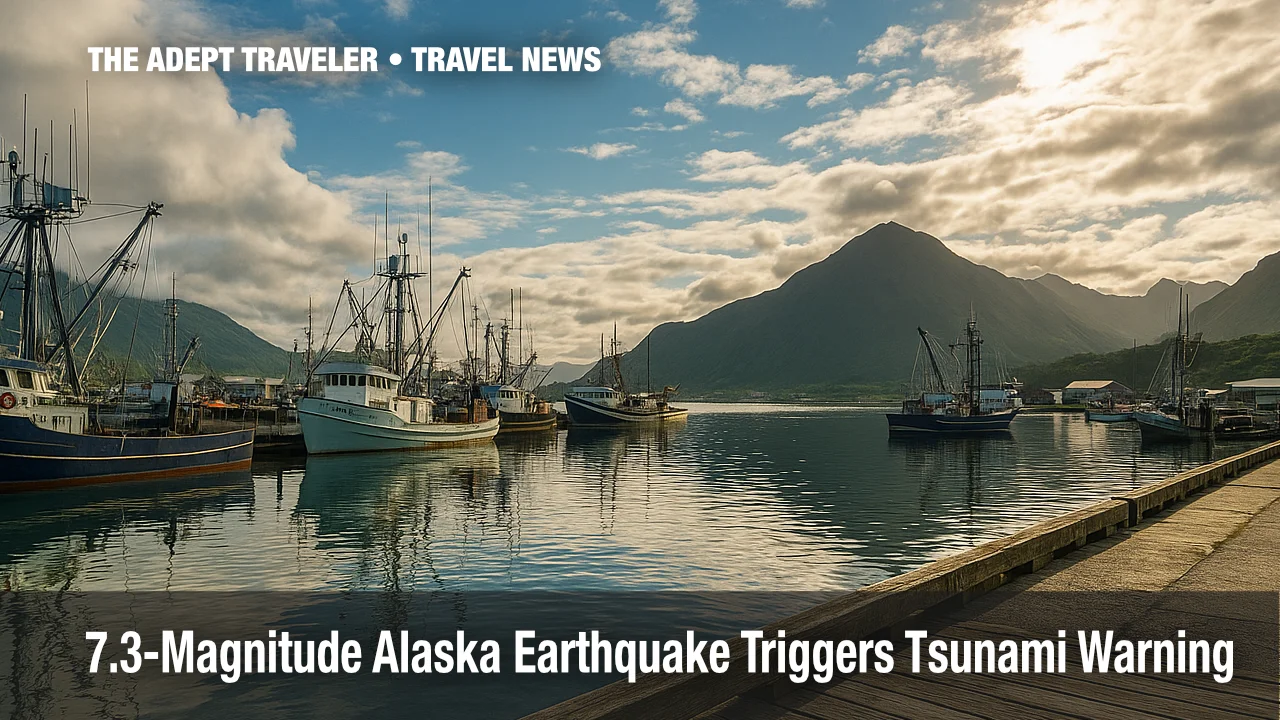7.3-Magnitude Alaska Earthquake Triggers Brief Tsunami Warning

A powerful Alaska earthquake shook the state's southern coast at 12:37 PM on July 16, 2025, sending residents from Sand Point to Unalaska racing uphill until officials lifted a brief tsunami warning. The offshore 7.3-magnitude event, centered fifty-five miles south of Sand Point, rippled through communities as far apart as Anchorage and Juneau. Thanks to swift alerts, orderly evacuations, and robust building standards, the region escaped major damage. Still, experts warn that aftershocks-and future large quakes-remain likely along this restless stretch of the Alaska Peninsula.
Key Points
- Epicenter 55 miles south of Sand Point, magnitude 7.3.
- Tsunami warning covered 700 miles of coastline, canceled by 2:45 PM.
- No critical infrastructure damage reported.
- Aftershock forecast: at least one magnitude 6 expected within one week.
- Why it matters: Travelers must understand Alaska's ongoing seismic risks and evacuation procedures.
Snapshot
Alaska's southern coast sits atop the Aleutian subduction zone, where the Pacific Plate dives beneath North America. Wednesday's quake ruptured an offshore fault at a shallow twelve-mile depth, producing strong shaking in Sand Point yet only gentle rolling in Homer and Anchorage. The National Tsunami Warning Center immediately issued a warning spanning Homer to Unimak Pass, advising coastal residents to reach zones at least fifty feet above sea level. Within seventy-eight minutes, water-level gauges showed only minor fluctuations, and officials downgraded the warning to an advisory, then canceled all alerts by mid-afternoon. The rapid response underscores Alaska's hard-earned expertise with seismic emergencies.
Background
Alaska experiences more large earthquakes than any other U.S. state because of constant strain along the Aleutian Trench. Since 2020, five magnitude-7 or greater events have struck the same offshore corridor, including the 2020 Simeonof and 2021 Chignik quakes. Each incident refines evacuation drills, public messaging, and infrastructure resilience. Modern harbor facilities, elevated fuel tanks, and reinforced runways help remote towns withstand strong shaking. Statewide, schools and businesses conduct regular tsunami walks, and siren networks link even isolated fishing villages. Wednesday's event validates those investments: shelves toppled and bottles shattered, yet airports, docks, and power lines remained intact.
Latest Developments
Immediate Evacuations
Sirens and cellphone alerts sounded within minutes. In Kodiak, Coast Guard personnel relocated to a hillside staging area while harbor masters cleared marinas. Along the Homer Spit, tourists abandoned boardwalk shops and followed blue-and-white evacuation route signs to higher ground. Social-media clips from Seward showed orderly lines of residents climbing Fourth Avenue toward designated safe zones. Local officials praised the calm demeanor that kept roads uncongested during the rush uphill.
Tsunami System Performance
The National Tsunami Warning Center's buoy network detected modest sea-level changes: about half a foot at Sand Point, even less at King Cove and Kodiak. Given those readings, scientists downgraded the warning to an advisory after seventy minutes, instructing people to stay off beaches until currents settled. By 2:45 PM, data confirmed no significant waves, and all alerts ended. Jeremy Zidek of Alaska's emergency management division called the exercise "a textbook demonstration of hazard communication."
Early Damage Reports
Sand Point, home to six hundred residents, bore the brunt of shaking. Police Chief Benjamin Allen reported no structural issues at the airport, harbor, or clinic. The Alaska Commercial Store lost half an aisle of glass bottles, filling the air with a pungent mix of barbecue sauce and pickles. Elsewhere, damage was limited to fallen picture frames and overturned potted plants. No injuries were reported.
Analysis
For travelers, Wednesday's quake reinforces two realities. First, Alaska remains seismically active, and itinerary planning must include knowledge of local sirens, evacuation maps, and shelter elevations. Coastal lodging often provides route diagrams; guests should study them on arrival. Second, the state's preparedness infrastructure is robust. Ports such as Kodiak and Homer have reinforced docks, while regional airlines perform post-quake runway inspections within hours. Cruise operators routinely practice rapid-departure protocols when tsunami alerts sound. The temporary closure of fishing harbors can delay charter excursions, yet most reopen quickly after inspections. Vacationers booked for the coming week should monitor aftershock advisories, secure travel insurance that covers delays, and pack flexible plans rather than rigid timetables.
Final Thoughts
Wednesday's Alaska earthquake ended without tragedy, thanks to offshore rupture, upgraded warning systems, and practiced communities. Yet the region's aftershock forecast-plus its historic record, including 1964's devastating 9.2-magnitude event-reminds travelers that vigilance never truly ends. Visitors who respect evacuation signage, keep go-bags ready, and heed official bulletins can still enjoy Alaska's wild beauty with confidence that the next Alaska earthquake will meet an equally seasoned response.
